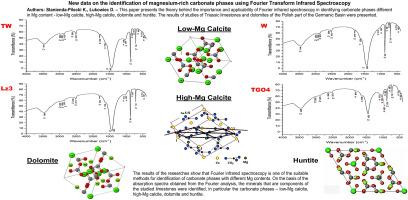傅里叶变换红外光谱法鉴别富镁碳酸盐相的新资料
IF 3.6
2区 地球科学
Q1 GEOSCIENCES, MULTIDISCIPLINARY
引用次数: 0
摘要
本文介绍了傅里叶红外光谱在鉴别不同镁含量碳酸盐相中的重要性和适用性。本文介绍了对日耳曼盆地波兰部分三叠纪石灰岩和白云岩样品的研究结果,这些样品是用这种方法分析的。FTIR方法的科学意义在于它能够识别不同镁含量的碳酸盐相,即使镁含量很低。FTIR是为数不多的提供这种可能性的方法之一。分析了低镁方解石、高镁方解石、白云石和猎石等物相。这些碳酸盐相是根据红外吸收光谱中的波数来确定的。灰岩中以低镁方解石为主。一些样品还含有少量的高镁方解石。白云石和狩猎石也被发现。白云岩和白云质灰岩中普遍存在高镁方解石和白云石。研究结果表明,Gogolin单元(下Muschelkalk)和Diplopor单元(中Muschelkalk)的岩石碳酸盐相含量差异最小,镁含量变化较大,而Tarnowice和Boruszowice单元(上Muschelkalk)的岩石碳酸盐相含量差异最大。结果表明,下Muschelkalk (Gogolin单元)和中Muschelkalk (Diplopor单元)的岩石为富含石英和高岭石的灰岩。相比之下,上Muschelkalk (Tarnowice和Boruszowice单元)的岩石为白云岩和白云质灰岩。研究结果表明,傅里叶红外光谱由于其易于使用和精度高,是识别含镁含量变化的碳酸盐相(包括含镁取代的碳酸盐相)最有效的方法之一。本文章由计算机程序翻译,如有差异,请以英文原文为准。

New data on the identification of magnesium-rich carbonate phases using Fourier Transform Infrared Spectroscopy
This paper presents the theory behind the importance and applicability of Fourier infrared spectroscopy in identifying carbonate phases with varying magnesium content. It presents the results of studies of Triassic limestone and dolomite samples taken from the Polish part of the Germanic Basin, which were analysed using this method. The scientific significance of the FTIR method lies in its ability to identify carbonate phases with varying magnesium content, even at low levels. FTIR is one of the few methods that offer such possibilities.
The following phases were analysed: low-Mg calcite, high-Mg calcite, dolomite and huntite. These carbonate phases were identified based on wave numbers occurring in the infrared absorption spectra. Low-Mg calcite is the dominant phase in the limestones. Some samples also contain a small amount of high-Mg calcite. Dolomite and huntite were also identified. High-Mg calcite and dolomite are prevalent in dolomites and dolomitic limestones. The research results indicate that the rocks of the Gogolin Unit (Lower Muschelkalk) and Diplopor Unit (Middle Muschelkalk) exhibit the least differentiation in carbonate phase content with varying magnesium contents, whereas the rocks of the Tarnowice and Boruszowice Units (Upper Muschelkalk) exhibit the most. The results suggest that the rocks of the Lower Muschelkalk (Gogolin Unit) and Middle Muschelkalk (Diplopor Unit) are quartz- and kaolinite-rich limestones. In contrast, the rocks of the Upper Muschelkalk (Tarnowice and Boruszowice units) are dolomites and dolomitic limestones. The results of the study demonstrate that Fourier infrared spectroscopy is one of the most effective methods for identifying carbonate phases with varying magnesium content, including those with magnesium substitution, due to its ease of use and high level of accuracy.
求助全文
通过发布文献求助,成功后即可免费获取论文全文。
去求助
来源期刊

Marine and Petroleum Geology
地学-地球科学综合
CiteScore
8.80
自引率
14.30%
发文量
475
审稿时长
63 days
期刊介绍:
Marine and Petroleum Geology is the pre-eminent international forum for the exchange of multidisciplinary concepts, interpretations and techniques for all concerned with marine and petroleum geology in industry, government and academia. Rapid bimonthly publication allows early communications of papers or short communications to the geoscience community.
Marine and Petroleum Geology is essential reading for geologists, geophysicists and explorationists in industry, government and academia working in the following areas: marine geology; basin analysis and evaluation; organic geochemistry; reserve/resource estimation; seismic stratigraphy; thermal models of basic evolution; sedimentary geology; continental margins; geophysical interpretation; structural geology/tectonics; formation evaluation techniques; well logging.
 求助内容:
求助内容: 应助结果提醒方式:
应助结果提醒方式:


